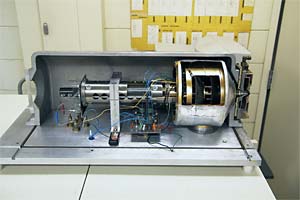
This lessons deals with the "source" of an isotope ratio mass
spectrometer, that is, the portion of the instrument where ions are
generated and accelerated into a mass or energy analyzer.
 The presentation introduces various methods of sample volatilization and
ionization, including thermal ionization, electron impact, and
sputtering. The process of thermal ionization is described in some
detail and includes a discussion of filament assemblies, the
Langmuir-Saha equation, and metal surface work functions. Various
lens configurations used to accelerate and focus ions down the flight
tube are also described.
The presentation introduces various methods of sample volatilization and
ionization, including thermal ionization, electron impact, and
sputtering. The process of thermal ionization is described in some
detail and includes a discussion of filament assemblies, the
Langmuir-Saha equation, and metal surface work functions. Various
lens configurations used to accelerate and focus ions down the flight
tube are also described.
 You can download the lecture as PDF
or PowerPoint.
You can download the lecture as PDF
or PowerPoint.
A separate presentation on inductively coupled plasma (ICP) ion sources is also included here courtesy of Gary Hieftje (Indiana University). The lecture provides an in-depth introduction to the advantages and disadvantages of the ICP as an ion source for high precision isotope ratio measurements.
 Download Hieftje's presentation
on ICP basics
(PDF or
PowerPoint).
Download Hieftje's presentation
on ICP basics
(PDF or
PowerPoint).
